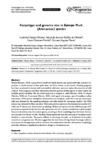Por favor, use este identificador para citar o enlazar este ítem:
http://www.alice.cnptia.embrapa.br/alice/handle/doc/1046186Registro completo de metadatos
| Campo DC | Valor | Lengua/Idioma |
|---|---|---|
| dc.contributor.author | OLIVEIRA, L. C. | pt_BR |
| dc.contributor.author | OLIVEIRA, M. do S. P. de | pt_BR |
| dc.contributor.author | DAVIDE, L. C. | pt_BR |
| dc.contributor.author | TORRES, G. A. | pt_BR |
| dc.date.accessioned | 2016-06-02T11:11:11Z | pt_BR |
| dc.date.available | 2016-06-02T11:11:11Z | pt_BR |
| dc.date.created | 2016-06-02 | pt_BR |
| dc.date.issued | 2016 | pt_BR |
| dc.identifier.citation | Comparative Cytogenetics, v. 10, n. 1, p. 17-25, 2016. | pt_BR |
| dc.identifier.uri | http://www.alice.cnptia.embrapa.br/alice/handle/doc/1046186 | pt_BR |
| dc.description | Euterpe (Martius, 1823), a genus from Central and South America, has species with high economic importance in Brazil, because of their palm heart and fruits, known as açaí berries. Breeding programs have been conducted to increase yield and establish cultivation systems to replace the extraction of wild material. These programs need basic information about the genome of these species to better explore the available genetic variability. The aim of this study was to compare E. edulis (Martius, 1824), E. oleracea (Martius, 1824) and E. precatoria (Martius, 1842), with regard to karyotype, type of interphase nucleus and nuclear DNA amount. Metaphase chromosomes and interphase nuclei from root tip meristematic cells were obtained by the squashing technique and solid stained for microscope analysis. The DNA amount was estimated by flow cytometry. There were previous reports on the chromosome number of E. edulis and E. oleracea, but chromosome morphology of these two species and the whole karyotype of E. precatoria are reported for the first time. The species have 2n=36, a number considered as a pleisomorphic feature in Arecoideae since the modern species, according to floral morphology, have the lowest chromosome number (2n=28 and 2n=30). The three Euterpe species also have the same type of interphase nuclei, classified as semi-reticulate. The species differed on karyotypic formulas, on localization of secondary constriction and genome size. The data suggest that the main forces driving Euterpe karyotype evolution were structural rearrangements, such as inversions and translocations that alter chromosome morphology, and either deletion or amplification that led to changes in chromosome size. | pt_BR |
| dc.language.iso | eng | eng |
| dc.rights | openAccess | eng |
| dc.subject | Evolução cromossômica | pt_BR |
| dc.subject | Citometria de fluxo | pt_BR |
| dc.title | Karyotype and genome size in Euterpe Mart. (Arecaceae) species. | pt_BR |
| dc.type | Artigo de periódico | pt_BR |
| dc.date.updated | 2016-11-30T11:11:11Z | pt_BR |
| dc.subject.thesagro | Açaí | pt_BR |
| dc.subject.thesagro | Genoma | pt_BR |
| riaa.ainfo.id | 1046186 | pt_BR |
| riaa.ainfo.lastupdate | 2016-11-30 | pt_BR |
| dc.identifier.doi | 10.3897/CompCytogen.v10i1.5522 | pt_BR |
| dc.contributor.institution | LUDMILA CRISTINA OLIVEIRA, UNIVERSIDADE FEDERAL DE LAVRAS | pt_BR |
| dc.contributor.institution | MARIA DO SOCORRO P DE OLIVEIRA, CPATU | eng |
| dc.contributor.institution | LISETE CHAMMA DAVIDE | eng |
| dc.contributor.institution | GIOVANA AUGUSTA TORRES, UNIVERSIDADE FEDERAL DE LAVRAS. | eng |
| Aparece en las colecciones: | Artigo em periódico indexado (CPATU)  | |
Ficheros en este ítem:
| Fichero | Descripción | Tamaño | Formato | |
|---|---|---|---|---|
| 2016Oliveira.pdf | 475,52 kB | Adobe PDF |  Visualizar/Abrir |









